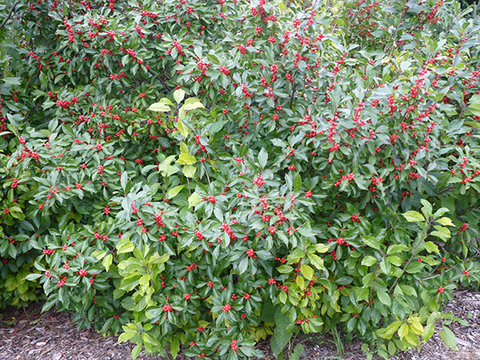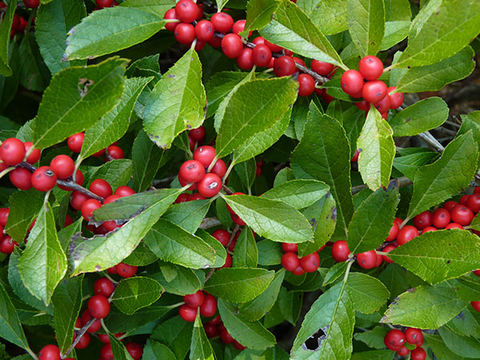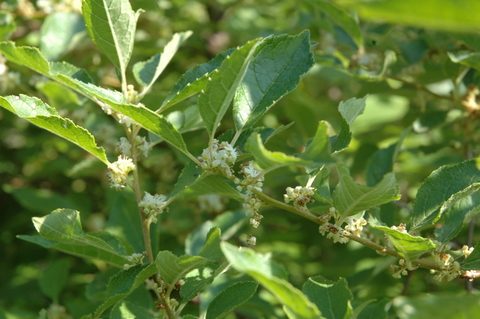(Ilex verticillata) is a native Minnesota shrub grown for its colorful and abundant fruit.
It can be used as a property border or to screen views. Plant several shrubs in a mass for wildlife food and habitat, or as a group of plants in the landscape.
Winterberry provides seasonal interest in autumn and early winter when female plants are covered in red, orange or yellow fruit.
Winterberry grows wild in acidic soils in forested wetlands or along edges of ponds, lakes and marshes.
Though winterberry fruit is a food source for some wildlife, it can be poisonous to pets and people.
Description
Deciduous shrub
Height: 3 to 15 feet
Width: 3 to 15 feet
Oval or rounded form
Dark green 2- to 3-inch leaves
Clusters of small, white flowers in early to mid-summer
Red, orange, or yellow fruit in fall and winter
Grows slowly and may spread by suckering
Growing winterberry
Hardiness zones: 3 to 9
Full sun to part shade
Best soil properties for winterberry:
Soil pH 4.5 to 6.5 (acidic). Have your soil tested by the U of M Soil Testing Lab
Adaptable to many soil types - sandy, loam, or clay
Moist to wet soils
Tolerates poorly-drained and compacted soils
Common problems
Tolerates Japanese beetles
Sensitive to de-icing salts
Leaves may turn yellow when planted in soil pH is higher than 6.5
Leaf spots and powdery mildew late in the season; these are only cosmetic and non-fatal
Visit What's wrong with my plant? – Winterberry for a list of the most common winterberry pests in Minnesota.
Cultivated varieties of winterberry for Minnesota
Winterberry is a dioecious species, meaning female flowers and male flowers grow on separate plants. To get berries on a female plant, a male plant must be near.
One male plant will pollinate about 20 female plants to produce fruit when planted within 40 feet of each other. Beyond 40 feet, one male will pollinate about four to five female plants.
Female cultivars
‘Afterglow’ - 6 feet tall by 5 feet wide, orange fruit, compact habit
‘Aurantiaca’ - 5 feet tall by 5 feet wide, orange fruit
Berry Heavy® - 8 feet tall by 8 feet wide, red fruit
Berry Nice® - 6 feet tall by 6 feet wide, red fruit
‘Cacapon’ - 5 feet tall by 5 feet wide, red fruit
First Editions® Wildfire™ - 7 feet tall by 8 feet wide, red fruit
‘Goldfinch’ - 4 feet tall by 4 feet wide, golden yellow fruit
‘Red Sprite’- 4 feet tall by 4 feet wide, red fruit, compact habit
‘Sparkleberry’ - 12 feet tall by 12 feet wide, red fruit
Winter Red® - 9 feet tall by 8 feet wide, red fruit
Male cultivars
‘Jim Dandy’- 6 feet tall by 5 feet wide
Plant with 'Afterglow', 'Aurantiaca', Berry Heavy®, Berry Nice®, 'Cacapon', First Editions® Wildfire™, 'Goldfinch', and 'Red Sparkler'
‘Southern Gentleman’ - 9 feet tall by 8 feet wide
Plant with 'Sparkleberry' and Winter Red®
‘Late male’ - 9 feet tall by 8 feet wide
Plant with Winter Red®
Reviewed in 2018





